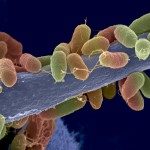Link to Pubmed [PMID] – 25810442
J. Infect. Dis. 2015 Oct;212(7):1140-9
BACKGROUND: Platelets were recently identified as a part of innate immunity. They are activated by contact with Aspergillus fumigatus; putative consequences include antifungal defense but also thrombosis, excessive inflammation, and thrombocytopenia. We aimed to identify those fungal surface structures that mediate interaction with platelets.
METHODS: Human platelets were incubated with Aspergillus conidia and hyphae, isolated wall components, or fungal surface mutants. Interaction was visualized microscopically; activation was quantified by flow cytometry of specific markers.
RESULTS: The capacity of A. fumigatus conidia to activate platelets is at least partly due to melanin, because this effect can be mimicked with “melanin ghosts”; a mutant lacking melanin showed reduced platelet stimulating potency. In contrast, conidial hydrophobin masks relevant structures, because an A. fumigatus mutant lacking the hydrophobin protein induced stronger platelet activation than wild-type conidia. A. fumigatus hyphae also contain surface structures that interact with platelets. Wall proteins, galactomannan, chitin, and β-glucan are not the relevant hyphal components; instead, the recently identified fungal polysaccharide galactosaminogalactan potently triggered platelet activation.
CONCLUSIONS: Conidial melanin and hydrophobin as well as hyphal galactosaminogalactan represent important pathogenicity factors that modulate platelet activity and thus might influence immune responses, inflammation, and thrombosis in infected patients.
